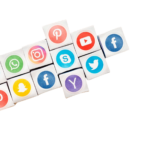To know the importance of digital marketing to the future of marketing in any business, we need to understand and manage audience interactions. The 5D defines the good times for consumers to interact with brands and reach out to businesses. In this ever-evolving digital age, the 5D’s of Digital Marketing serve as the pillars for businesses to connect with their target audience. These interconnected elements ensure a strategic and effective approach to reaching and engaging customers online. Let’s explore the 5D’s and how they shape digital marketing.

Digital Devices
 Digital device is the hardware through which audiences access digital content. Audiences experience brands when interacting with business websites and mobile applications through a combination of connected devices. From smartphones and tablets to desktops and wearables, digital devices act as the first point of contact for your audience. Optimizing your marketing strategies to be device-friendly ensures a seamless experience for users, no matter how they interact with your brand.
Digital device is the hardware through which audiences access digital content. Audiences experience brands when interacting with business websites and mobile applications through a combination of connected devices. From smartphones and tablets to desktops and wearables, digital devices act as the first point of contact for your audience. Optimizing your marketing strategies to be device-friendly ensures a seamless experience for users, no matter how they interact with your brand.
Digital Platforms
 Digital platform is the spaces where interactions occur. Most of the digital devices interact with browsers or applications on major platforms or services. Platforms like Google, Facebook, Instagram, LinkedIn, YouTube and e-commerce sites are essential hubs for digital marketing. Each platform has unique algorithms and user demographics, making it crucial to tailor your marketing efforts to suit each one.
Digital platform is the spaces where interactions occur. Most of the digital devices interact with browsers or applications on major platforms or services. Platforms like Google, Facebook, Instagram, LinkedIn, YouTube and e-commerce sites are essential hubs for digital marketing. Each platform has unique algorithms and user demographics, making it crucial to tailor your marketing efforts to suit each one.
Digital Media
 The communication channels used to deliver the message is the Digital media. There are various paid, owned and acquired communication channels to reach and entice the audience. This includes social media, email, paid advertisements, content marketing, and search engines. A balanced media strategy ensures maximum reach and engagement, allowing brands to build relationships and foster trust with their audience.
The communication channels used to deliver the message is the Digital media. There are various paid, owned and acquired communication channels to reach and entice the audience. This includes social media, email, paid advertisements, content marketing, and search engines. A balanced media strategy ensures maximum reach and engagement, allowing brands to build relationships and foster trust with their audience.
Digital Data
 Digital data can be summed up as the insights gathered from online behavior. Data is at the heart of digital marketing. Analyzing customer preferences, demographics, and behaviors allows businesses to make informed decisions, personalize campaigns, and measure success accurately. Insights businesses collect their audience profiles and their interactions with companies that are now required to be protected by law in many countries.
Digital data can be summed up as the insights gathered from online behavior. Data is at the heart of digital marketing. Analyzing customer preferences, demographics, and behaviors allows businesses to make informed decisions, personalize campaigns, and measure success accurately. Insights businesses collect their audience profiles and their interactions with companies that are now required to be protected by law in many countries.
Digital Technology
 Digital Technology is the tool that enables digital marketing. It is the marketing technique used by businesses to create interactive experiences from websites and cell phone apps to in-store kiosks and email campaigns. From AI and machine learning to marketing automation tools and chatbots, technology drives innovation in digital marketing. Leveraging the latest tech ensures efficiency, precision, and scalability in campaigns.
Digital Technology is the tool that enables digital marketing. It is the marketing technique used by businesses to create interactive experiences from websites and cell phone apps to in-store kiosks and email campaigns. From AI and machine learning to marketing automation tools and chatbots, technology drives innovation in digital marketing. Leveraging the latest tech ensures efficiency, precision, and scalability in campaigns.
Conclusion
Mastering the 5D’s of Digital Marketing is essential for brands aiming to thrive in today’s digital-first world. By understanding and integrating these elements into your strategy, you can create campaigns that resonate with your audience and deliver measurable results.
Let Exposure help you navigate the 5D’s for your brand’s digital transformation. Reach out to us today!




